YAMAHA BT1100 2002 Repair Manual
Manufacturer: YAMAHA, Model Year: 2002, Model line: BT1100, Model: YAMAHA BT1100 2002Pages: 96, PDF Size: 3.32 MB
Page 61 of 96
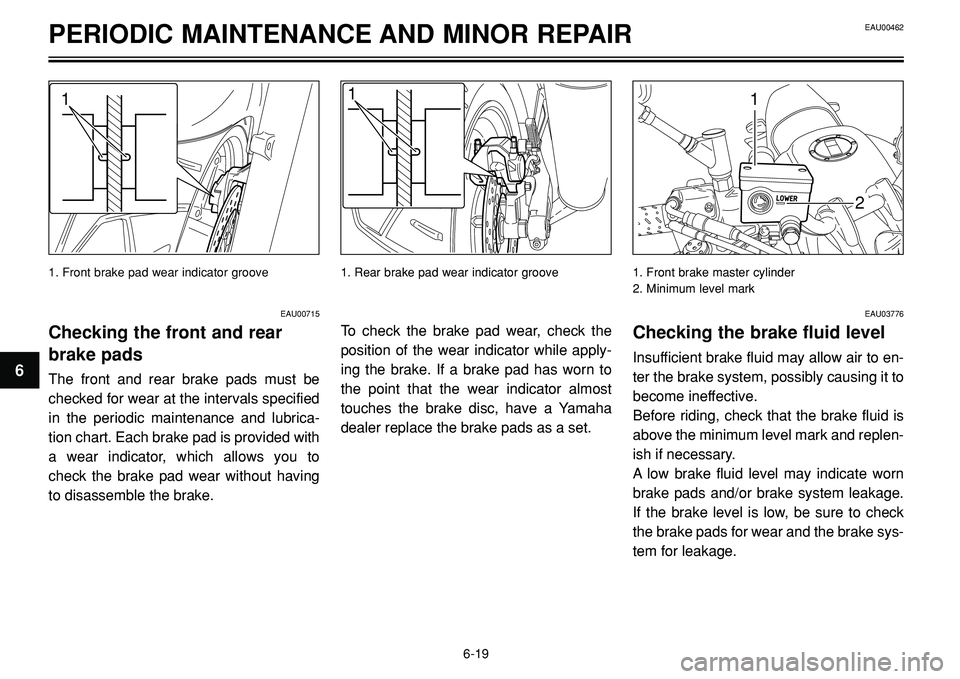
1. Front brake pad wear indicator groove
PERIODIC MAINTENANCE AND MINOR REPAIR
11
2
1
EAU00715
Checking the front and rear
brake pads
The front and rear brake pads must be
checked for wear at the intervals specified
in the periodic maintenance and lubrica-
tion chart. Each brake pad is provided with
a wear indicator, which allows you to
check the brake pad wear without having
to disassemble the brake. To check the brake pad wear, check the
position of the wear indicator while apply-
ing the brake. If a brake pad has worn to
the point that the wear indicator almost
touches the brake disc, have a Yamaha
dealer replace the brake pads as a set.
EAU03776
Checking the brake fluid level
Insufficient brake fluid may allow air to en-
ter the brake system, possibly causing it to
become ineffective.
Before riding, check that the brake fluid is
above the minimum level mark and replen-
ish if necessary.
A low brake fluid level may indicate worn
brake pads and/or brake system leakage.
If the brake level is low, be sure to check
the brake pads for wear and the brake sys-
tem for leakage.
EAU00462
6-19
6
1. Front brake master cylinder
2. Minimum level mark 1. Rear brake pad wear indicator groove
Page 62 of 96
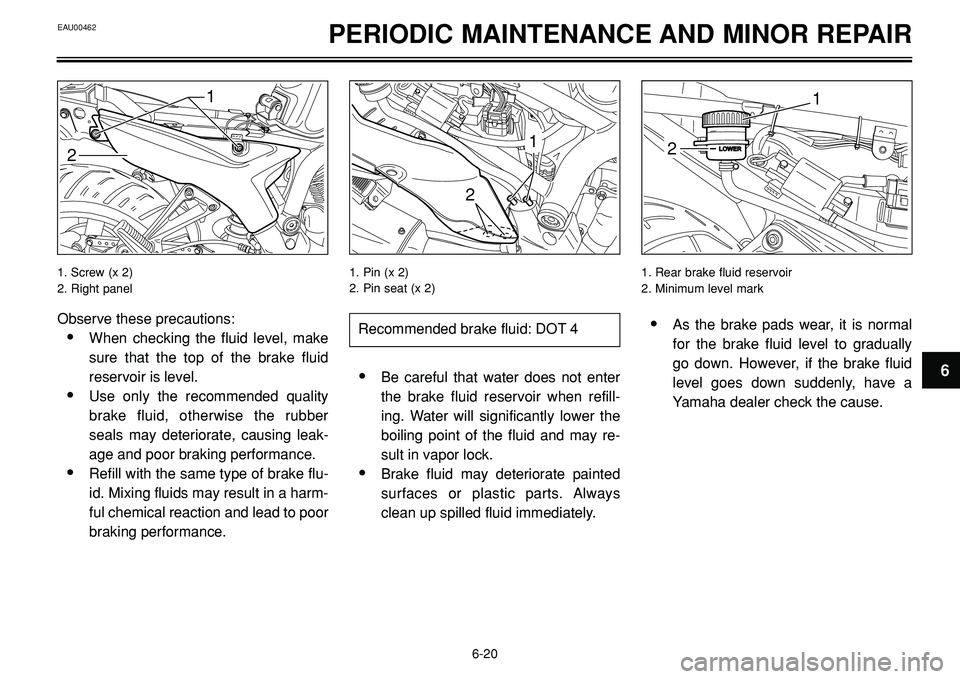
EAU00462PERIODIC MAINTENANCE AND MINOR REPAIR
1
2
Observe these precautions:
•When checking the fluid level, make
sure that the top of the brake fluid
reservoir is level.
•Use only the recommended quality
brake fluid, otherwise the rubber
seals may deteriorate, causing leak-
age and poor braking performance.
•Refill with the same type of brake flu-
id. Mixing fluids may result in a harm-
ful chemical reaction and lead to poor
braking performance.
•Be careful that water does not enter
the brake fluid reservoir when refill-
ing. Water will significantly lower the
boiling point of the fluid and may re-
sult in vapor lock.
•Brake fluid may deteriorate painted
surfaces or plastic parts. Always
clean up spilled fluid immediately.
•As the brake pads wear, it is normal
for the brake fluid level to gradually
go down. However, if the brake fluid
level goes down suddenly, have a
Yamaha dealer check the cause.
6-20
6
1. Screw (x 2)
2. Right panel
2
1
1. Pin (x 2)
2. Pin seat (x 2)
Recommended brake fluid: DOT 4
21
1. Rear brake fluid reservoir
2. Minimum level mark
Page 63 of 96
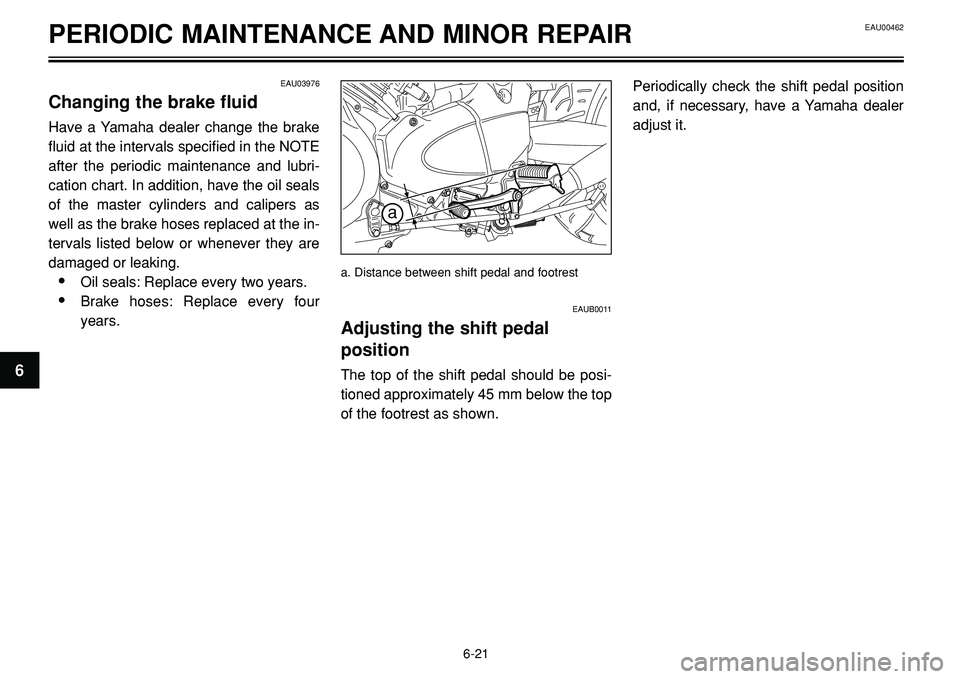
EAU00462PERIODIC MAINTENANCE AND MINOR REPAIR
a
A
EAU03976
Changing the brake fluid
Have a Yamaha dealer change the brake
fluid at the intervals specified in the NOTE
after the periodic maintenance and lubri-
cation chart. In addition, have the oil seals
of the master cylinders and calipers as
well as the brake hoses replaced at the in-
tervals listed below or whenever they are
damaged or leaking.
•Oil seals: Replace every two years.
•Brake hoses: Replace every four
years.
a. Distance between shift pedal and footrest
EAUB0011
Adjusting the shift pedal
position
The top of the shift pedal should be posi-
tioned approximately 45 mm below the top
of the footrest as shown. Periodically check the shift pedal position
and, if necessary, have a Yamaha dealer
adjust it.
6-21
6
Page 64 of 96
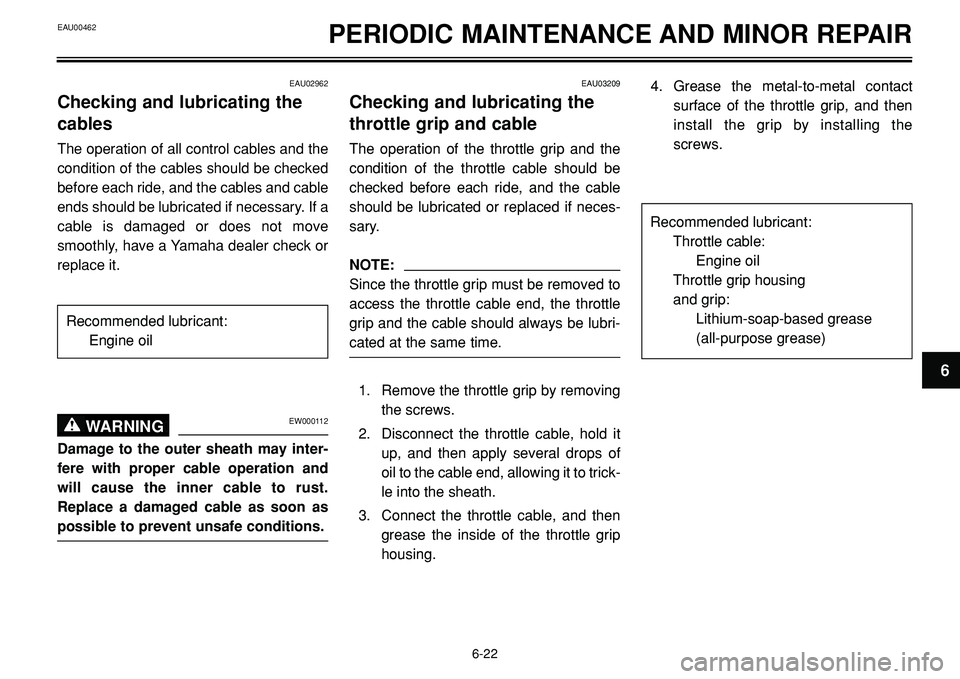
EAU00462PERIODIC MAINTENANCE AND MINOR REPAIR
EAU02962
Checking and lubricating the
cables
The operation of all control cables and the
condition of the cables should be checked
before each ride, and the cables and cable
ends should be lubricated if necessary. If a
cable is damaged or does not move
smoothly, have a Yamaha dealer check or
replace it.
EW000112WARNING0
Damage to the outer sheath may inter-
fere with proper cable operation and
will cause the inner cable to rust.
Replace a damaged cable as soon as
possible to prevent unsafe conditions.
EAU03209
Checking and lubricating the
throttle grip and cable
The operation of the throttle grip and the
condition of the throttle cable should be
checked before each ride, and the cable
should be lubricated or replaced if neces-
sary.
NOTE:
Since the throttle grip must be removed to
access the throttle cable end, the throttle
grip and the cable should always be lubri-
cated at the same time.
1. Remove the throttle grip by removing
the screws.
2. Disconnect the throttle cable, hold it
up, and then apply several drops of
oil to the cable end, allowing it to trick-
le into the sheath.
3. Connect the throttle cable, and then
grease the inside of the throttle grip
housing.4. Grease the metal-to-metal contact
surface of the throttle grip, and then
install the grip by installing the
screws.
6-22
6
Recommended lubricant:
Engine oil
Recommended lubricant:
Throttle cable:
Engine oil
Throttle grip housing
and grip:
Lithium-soap-based grease
(all-purpose grease)
Page 65 of 96
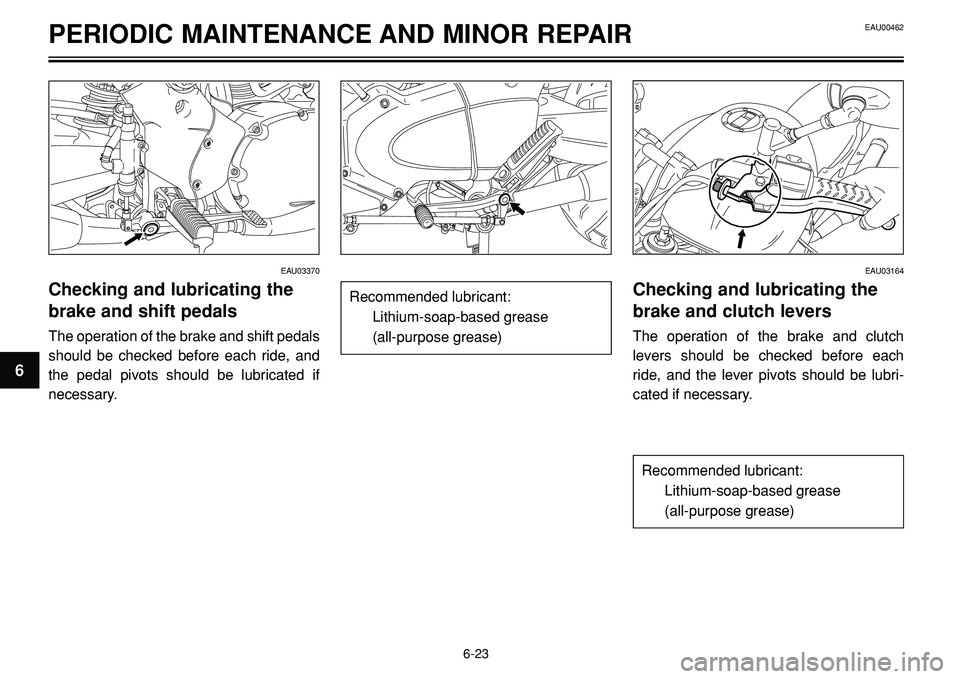
PERIODIC MAINTENANCE AND MINOR REPAIR
EAU03370
Checking and lubricating the
brake and shift pedals
The operation of the brake and shift pedals
should be checked before each ride, and
the pedal pivots should be lubricated if
necessary.
EAU03164
Checking and lubricating the
brake and clutch levers
The operation of the brake and clutch
levers should be checked before each
ride, and the lever pivots should be lubri-
cated if necessary.
EAU00462
6-23
6
Recommended lubricant:
Lithium-soap-based grease
(all-purpose grease)
Recommended lubricant:
Lithium-soap-based grease
(all-purpose grease)
Page 66 of 96
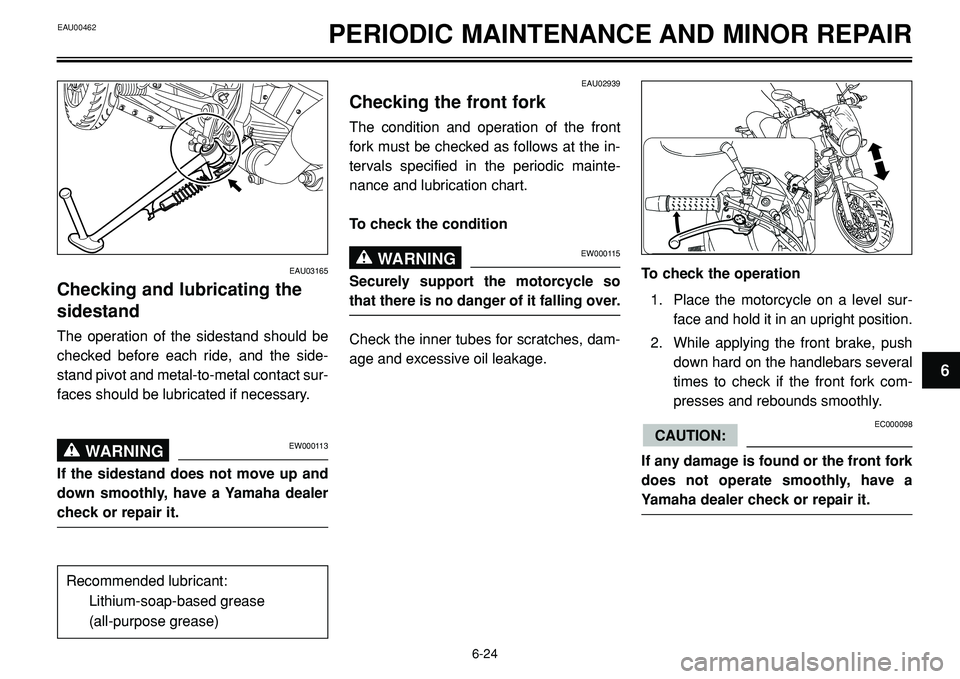
EAU00462PERIODIC MAINTENANCE AND MINOR REPAIR
EAU02939
Checking the front fork
The condition and operation of the front
fork must be checked as follows at the in-
tervals specified in the periodic mainte-
nance and lubrication chart.
To check the condition
EW000115WARNING0
Securely support the motorcycle so
that there is no danger of it falling over.
Check the inner tubes for scratches, dam-
age and excessive oil leakage.
To check the operation
1. Place the motorcycle on a level sur-
face and hold it in an upright position.
2. While applying the front brake, push
down hard on the handlebars several
times to check if the front fork com-
presses and rebounds smoothly.
EC000098
If any damage is found or the front fork
does not operate smoothly, have a
Yamaha dealer check or repair it.
CAUTION:
6-24
6
EAU03165
Checking and lubricating the
sidestand
The operation of the sidestand should be
checked before each ride, and the side-
stand pivot and metal-to-metal contact sur-
faces should be lubricated if necessary.
EW000113WARNING0
If the sidestand does not move up and
down smoothly, have a Yamaha dealer
check or repair it.
Recommended lubricant:
Lithium-soap-based grease
(all-purpose grease)
Page 67 of 96
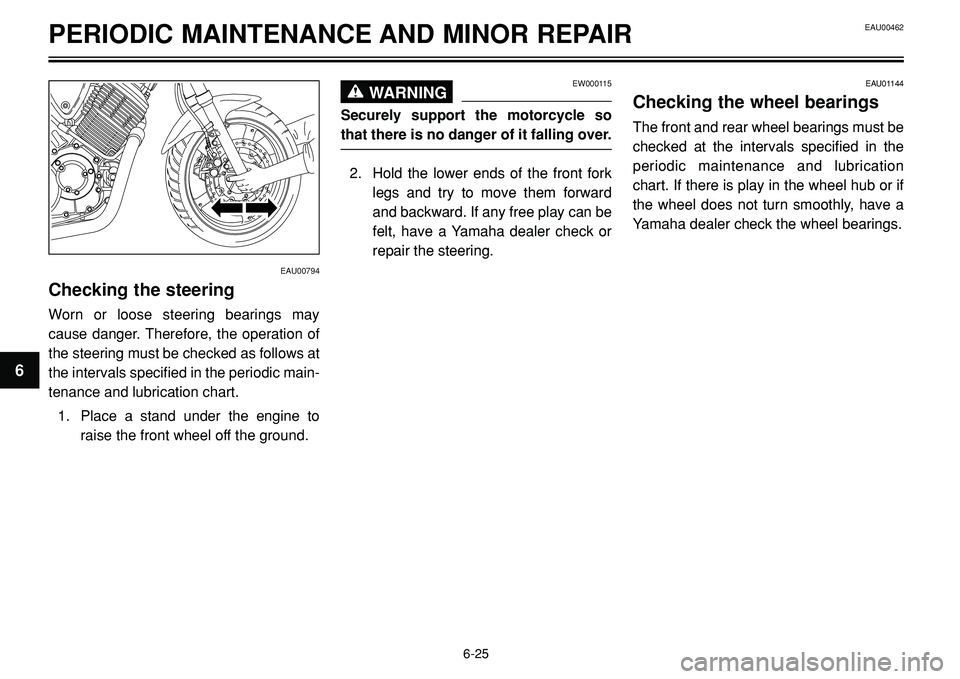
EAU00462PERIODIC MAINTENANCE AND MINOR REPAIR
EAU00794
Checking the steering
Worn or loose steering bearings may
cause danger. Therefore, the operation of
the steering must be checked as follows at
the intervals specified in the periodic main-
tenance and lubrication chart.
1. Place a stand under the engine to
raise the front wheel off the ground.
EW000115WARNING0
Securely support the motorcycle so
that there is no danger of it falling over.
2. Hold the lower ends of the front fork
legs and try to move them forward
and backward. If any free play can be
felt, have a Yamaha dealer check or
repair the steering.
EAU01144
Checking the wheel bearings
The front and rear wheel bearings must be
checked at the intervals specified in the
periodic maintenance and lubrication
chart. If there is play in the wheel hub or if
the wheel does not turn smoothly, have a
Yamaha dealer check the wheel bearings.
6-25
6
Page 68 of 96
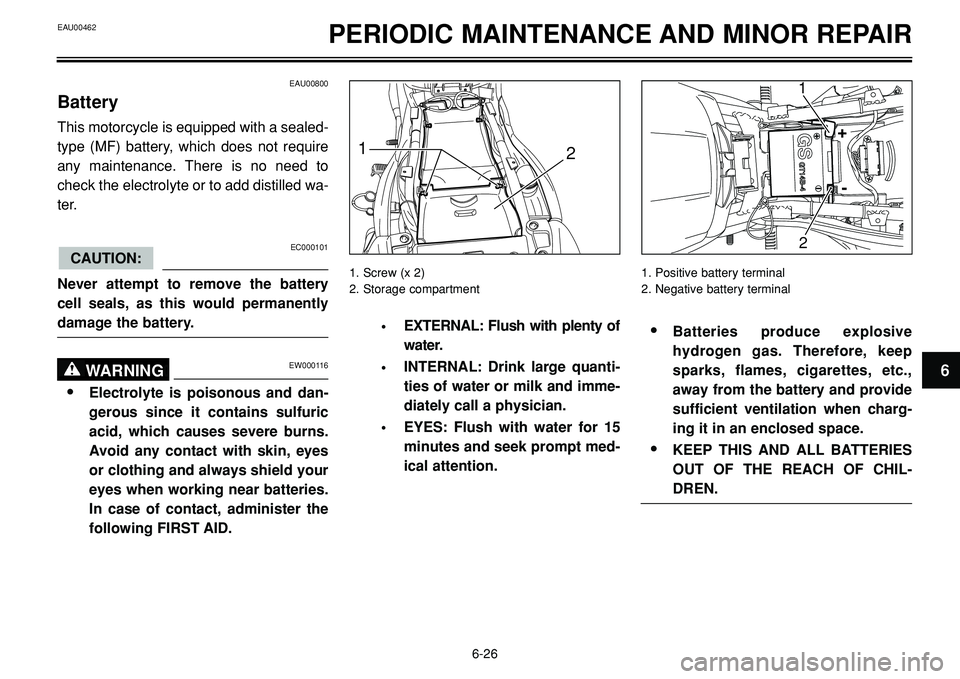
EAU00462PERIODIC MAINTENANCE AND MINOR REPAIR
EAU00800
Battery
This motorcycle is equipped with a sealed-
type (MF) battery, which does not require
any maintenance. There is no need to
check the electrolyte or to add distilled wa-
ter.
EC000101
Never attempt to remove the battery
cell seals, as this would permanently
damage the battery.
EW000116WARNING0
•Electrolyte is poisonous and dan-
gerous since it contains sulfuric
acid, which causes severe burns.
Avoid any contact with skin, eyes
or clothing and always shield your
eyes when working near batteries.
In case of contact, administer the
following FIRST AID.
CAUTION:
•EXTERNAL: Flush with plenty of
water.
•INTERNAL: Drink large quanti-
ties of water or milk and imme-
diately call a physician.
•EYES: Flush with water for 15
minutes and seek prompt med-
ical attention.
•Batteries produce explosive
hydrogen gas. Therefore, keep
sparks, flames, cigarettes, etc.,
away from the battery and provide
sufficient ventilation when charg-
ing it in an enclosed space.
•KEEP THIS AND ALL BATTERIES
OUT OF THE REACH OF CHIL-
DREN.
6-26
6
12
1
2
+
-
1. Screw (x 2)
2. Storage compartment1. Positive battery terminal
2. Negative battery terminal
Page 69 of 96
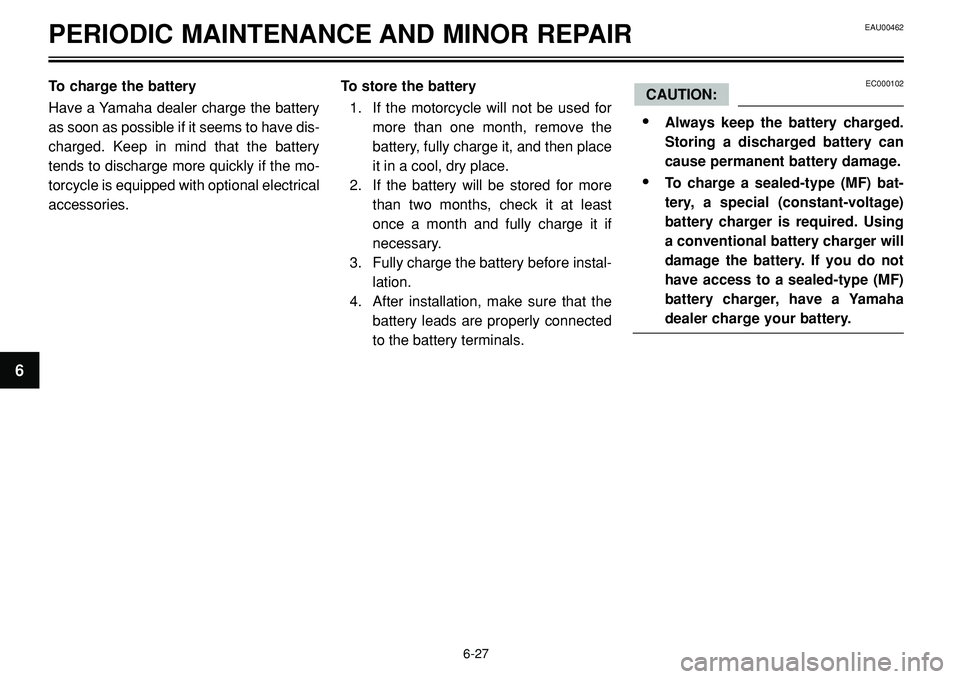
EAU00462PERIODIC MAINTENANCE AND MINOR REPAIR
To charge the battery
Have a Yamaha dealer charge the battery
as soon as possible if it seems to have dis-
charged. Keep in mind that the battery
tends to discharge more quickly if the mo-
torcycle is equipped with optional electrical
accessories.To store the battery
1. If the motorcycle will not be used for
more than one month, remove the
battery, fully charge it, and then place
it in a cool, dry place.
2. If the battery will be stored for more
than two months, check it at least
once a month and fully charge it if
necessary.
3. Fully charge the battery before instal-
lation.
4. After installation, make sure that the
battery leads are properly connected
to the battery terminals.EC000102
•Always keep the battery charged.
Storing a discharged battery can
cause permanent battery damage.
•To charge a sealed-type (MF) bat-
tery, a special (constant-voltage)
battery charger is required. Using
a conventional battery charger will
damage the battery. If you do not
have access to a sealed-type (MF)
battery charger, have a Yamaha
dealer charge your battery.
CAUTION:
6-27
6
Page 70 of 96
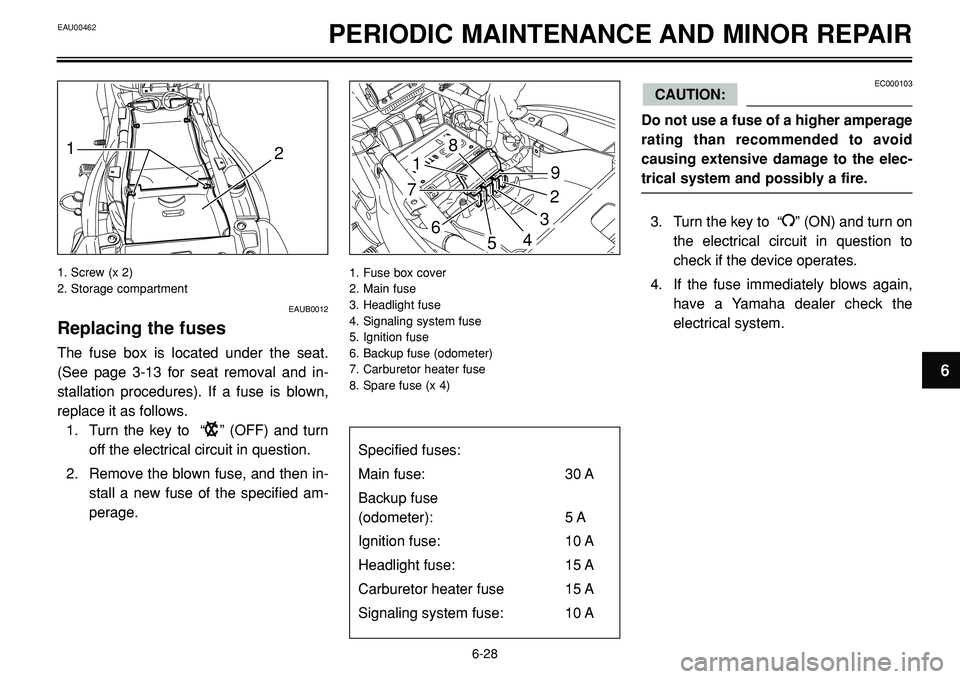
EAU00462PERIODIC MAINTENANCE AND MINOR REPAIR
128
1
7
9
2
3
546
EAUB0012
Replacing the fuses
The fuse box is located under the seat.
(See page 3-13 for seat removal and in-
stallation procedures). If a fuse is blown,
replace it as follows.
1. Turn the key to “
B” (OFF) and turn
off the electrical circuit in question.
2. Remove the blown fuse, and then in-
stall a new fuse of the specified am-
perage.
1. Screw (x 2)
2. Storage compartment
EC000103
Do not use a fuse of a higher amperage
rating than recommended to avoid
causing extensive damage to the elec-
trical system and possibly a fire.
3. Turn the key to “
I” (ON) and turn on
the electrical circuit in question to
check if the device operates.
4. If the fuse immediately blows again,
have a Yamaha dealer check the
electrical system.
CAUTION:
1. Fuse box cover
2. Main fuse
3. Headlight fuse
4. Signaling system fuse
5. Ignition fuse
6. Backup fuse (odometer)
7. Carburetor heater fuse
8. Spare fuse (x 4)
6-28
6
Specified fuses:
Main fuse: 30 A
Backup fuse
(odometer): 5 A
Ignition fuse: 10 A
Headlight fuse: 15 A
Carburetor heater fuse 15 A
Signaling system fuse: 10 A